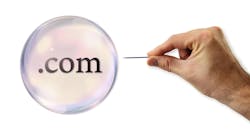The Perils of Irrational Exuberance
The 25th Anniversary of the Dot-Com Boom
On March 10, 2000, the value of internet stocks riding the waves of hype created by the newly commercialized internet reached their peak. Soon after, the "Dot-Com Boom" became the "Dot-Com Bubble" and burst spectacularly. The impact on technology fields, particularly fiber optics, was devastating. I lived through the whole Dot-Com Boom, bubble and bust, so I’m speaking from experience.
Most people today do not remember the world before the internet. Some of us in the tech businesses were using email back in the 1980s. I registered my name as an internet domain in 1992. In 1993, the first web browser, Mosaic, was introduced, and the World Wide Web became available to a widespread audience. Some of us techie nerds figured out how to use it and started creating web pages. My first page was one of the first 30,000 web pages.
Hundreds of companies rode the boom up and then fell back to Earth; many did not survive.
The U.S. government provided seed money to commercialize the internet. That helped inform the public about the potential uses of the internet. What followed was an explosion of interest and investment, creating a major boom in building fiber optic networks to support the Internet.
During the boom years (1995-2000), perhaps as much as $2 trillion was spent building 80-90 million miles of fiber optic networks. But in 2001, after the bust, it was estimated that 95% of the fiber was dark fiber; there simply was not enough internet traffic or revenue being produced to justify the investment. The internet boom was exposed as a bubble and subsequently burst. Hundreds of companies rode the boom up and then fell back to Earth; many did not survive.
The value of stocks tells the economic story from the macro point of view. From 1995 to March 2000, the value of tech stocks rose by 800%, only to fall more than 80% after the bubble burst. Large companies saw their market value rise spectacularly, only to fall even more spectacularly. For example, Corning stock was valued at about $12 in 1995, peaked at over $100 in October 2000, and fell to around $2 in October 2002. JDSU (now split into Viavi and Lumentum) went from ~$150 peak to $2, but is harder to track because of its many acquisitions and stock splits.
More than the stock value was affected by the boom and bubble bursting. Fiber optic companies expanded to fill orders from network builders and service providers rushing to build new fiber optic networks for the internet. The sales of fiber optic products dropped by 60-80% as many projects came to an abrupt halt. Real numbers are hard to find, but Corning revenue (including steady revenue of about $2 billion of other products than fiber) went from $3.8 billion in 1997 to $7 billion in 2000, with a forecast of $10 billion in 2002. Actual sales for 2002 were $4 billion, about half fiber, so fiber sales dropped about 60-70%.
The lost collective wisdom about fiber optics probably matches the loss in stock prices, but unlike stock prices, it is harder, if not impossible, to recover.
The industry suddenly had extreme overcapacity. Companies that had invested heavily in expansion closed or contracted to try to survive; many did not. Corning reportedly laid off 16,000 workers and shut down fiber production for a while. JDSU dropped from ~29,000 employees to ~5,000. Network developers like Global Crossing, NorthPoint Communications and WorldCom all ultimately filed for bankruptcy protection. Even ENRON was one of the players.
Two important things were lost when the bubble burst—technology and wisdom. Many companies had expected massive sales growth, so they started what was popular at the time: outsourcing, mostly to China. When these companies failed, the technology stayed with the Chinese partners; that’s the main reason most fiber optic components and equipment are now made in China.
The second thing lost was wisdom, the knowledge and experience of many of the pioneers of fiber optics. They were laid off in droves, and many were at an age that retirement was an option. The lost collective wisdom about fiber optics probably matches the loss in stock prices, but unlike stock prices, it is harder, if not impossible, to recover.
What caused the Dot-Com Bubble? The answer is "hype," overselling the idea of the internet and online activity long before the "killer apps" like search engines, social media and online marketplaces were ready and became irresistible to the public. As a result, there was an investment frenzy, but the real markets did not develop before the investors backed out. Fiber optic manufacturers were caught up in the frenzy.
Federal Reserve Chairman Alan Greenspan coined a new term for hype in a speech about the stock market's meteoric rise during the Dot-Com Bubble: "But how do we know when irrational exuberance has unduly escalated asset values, which then become subject to unexpected and prolonged contractions…"
The fiber optic market recovered slowly. The world's telecom networks continued getting built, converting from legacy telecom standards to internet protocols, eventually using all the dark fiber installed during the Boom years, and enjoying the price drops caused by overcapacity. Verizon boosted the market beginning around 2005 when it started FiOS FTTH. Steve Jobs’ introduction of the iPhone in 2007 drove the expansion of wireless networks. Streaming really drove the need for fiber, and the COVID-19 pandemic—with work/study/everything from home—demanded more and more fiber.
Now the demand is based on AI—or is that going to end up as just another bubble too? Tech is notoriously poor at learning from its mistakes.
About the Author
Jim Hayes
Fiber Optic Expert
Jim Hayes is the Fiber Optic Expert columnist for ISE Magazine. He is a lifelong techie who has been involved in the fiber optic industry since the late 1970s. He founded one of the world's first fiber optic test equipment companies, FOTEC, which was acquired by Fluke in 2000, and he was a co-founder of the Fiber Optic Association (FOA), the international professional society of fiber optics, in 1995.
Jim is a writer and trainer and the President of FOA. He is the author of nine books on fiber optics and cabling and writes for several magazines.
Jim and his wife, Karen, who is the GM of the FOA, have traveled the world for the FOA helping set up schools to train the workers who design, build, and operate today's communications networks. The FOA offers nearly 1,000 pages of online technical materials, over 100 videos, and two dozen free self-study courses online.
For more information, email [email protected] or visit www.jimhayes.com.
To learn more about The Fiber Optic Association, visit www.thefoa.org. Follow them on Facebook: FiberOpticAssociation, LinkedIn: company/the-fiber-optic-association-inc-foa, and YouTube: user/thefoainc.

